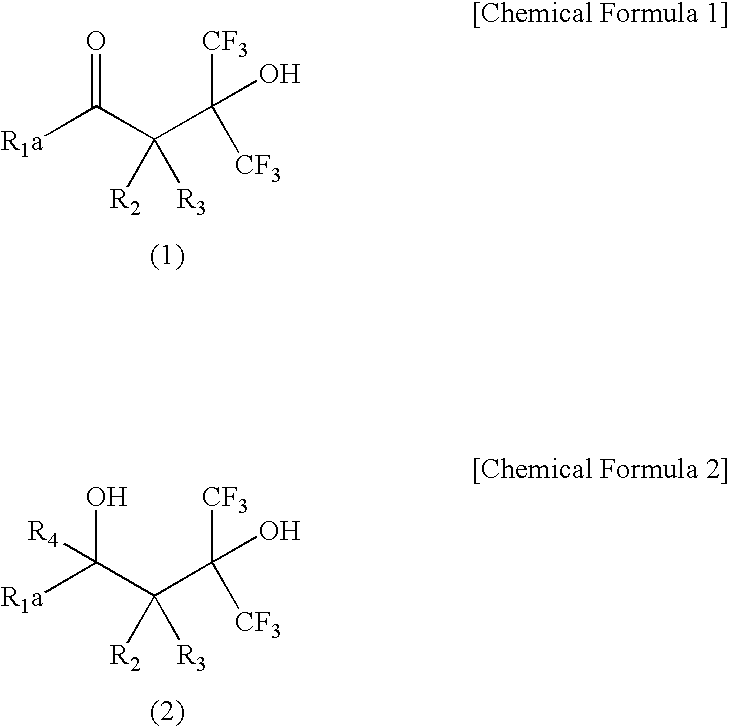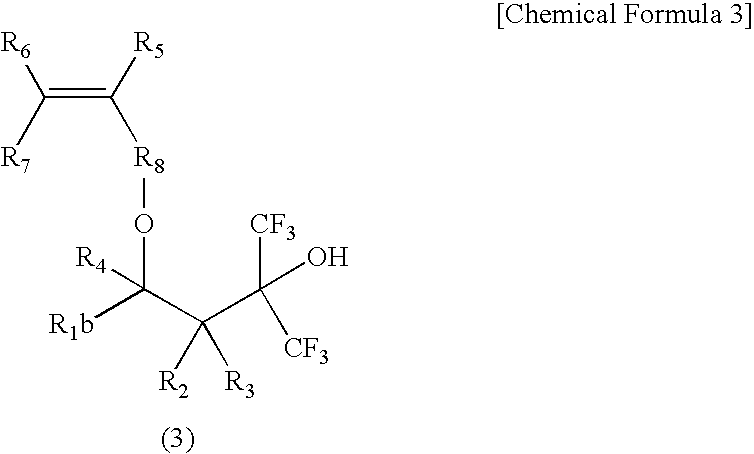Fluorine-Containing Cyclic Compound, Fluorine-Containing Polymer Compound, Resist Material Using Same and Method for Forming Pattern
a technology of cyclic compound and polymer compound, which is applied in the direction of basic electric elements, electrical equipment, electrical measurements, etc., can solve the problems of inability to use, high light absorption of novolac and polyvinyl phenol series resins, and inability to use, etc., to achieve high etching resistance, high transparency, and high adhesion to substra
- Summary
- Abstract
- Description
- Claims
- Application Information
AI Technical Summary
Benefits of technology
Problems solved by technology
Method used
Image
Examples
example 1
Synthesis of Compound 2
[0053]
[0054] A 50 ml autoclave made of SUS was charged with 2-acetyl-5-norbornene 1 (37.0 g) and concentrated sulfuric acid (0.17 g), followed by sealing. Hexafluoroacetone (65.0 g) was weighed and put into this, followed by heating in an oil bath of 60° C. and stirring for 23 hr. After the reaction, the autoclave was cooled down, followed by adding saturated sodium bicarbonate aqueous solution to the contents and then extraction by adding toluene. The organic phase was washed with saturated brine, followed by concentration and then vacuum distillation, thereby obtaining 23.4 g of a colorless, transparent liquid. This was analyzed by infrared absorption spectrum (IR), nuclear magnetic resonance spectrum (NMR) and a gas chromatograph mass spectrometer (GC-MS). As a result, it was a mixture of two isomers (Isomer 1 and Isomer 2) of the compound 2. An isomer ratio of Isomer 1 to Isomer 2 was 75:25.
Property Data
Compound 2
[0055] IR (cm-1): (a mixture of Isomer...
example 2
Synthesis of Compound 3
[0060]
[0061] A 100 ml round-bottom flask equipped with a reflux condenser and a stirrer was charged with the compound 2 (5.2 g) and ethyl alcohol (25 ml), followed by adding NaBH4 (0.3 g) with stirring at room temperature and then stirring at room temperature for 30 min. After the reaction, the contents were added to diluted hydrochloric acid (100 ml), followed by adding diisopropyl ether (200 ml) to this to conduct extraction. It was separated into two layers, and the organic layer was taken, followed by washing with saturated sodium bicarbonate aqueous solution and saturated brine. The obtained solution was concentrated, followed by recrystallization with n-heptane, thereby obtaining white-color crystals (2.2 g). This was analyzed by infrared absorption spectrum (IR), nuclear magnetic resonance spectrum (NMR) and a gas chromatograph mass spectrometer (GC-MS). As a result, it was a mixture of four isomers (Isomers 1-4) of the compound 3. An isomer ratio of Is...
example 3
Synthesis of Compound 4
[0066]
[0067] A 100 ml round-bottom flask equipped with a reflux condenser and a stirrer was charged with 2-acetyl-5-norbornene 1 (64 g), a catalyst (3.4 g) having 5 wt % palladium carried on activated carbon, and methyl alcohol (200 ml). The inside of the flask was turned into hydrogen atmosphere, followed by stirring at room temperature for 14 hours. After the reaction, the contents were filtered by Celite, and the filtrate was subjected to vacuum distillation, thereby obtaining the compound 4 (53.3 g).
PUM
| Property | Measurement | Unit |
|---|---|---|
| width | aaaaa | aaaaa |
| temperature | aaaaa | aaaaa |
| temperature | aaaaa | aaaaa |
Abstract
Description
Claims
Application Information
 Login to View More
Login to View More - R&D
- Intellectual Property
- Life Sciences
- Materials
- Tech Scout
- Unparalleled Data Quality
- Higher Quality Content
- 60% Fewer Hallucinations
Browse by: Latest US Patents, China's latest patents, Technical Efficacy Thesaurus, Application Domain, Technology Topic, Popular Technical Reports.
© 2025 PatSnap. All rights reserved.Legal|Privacy policy|Modern Slavery Act Transparency Statement|Sitemap|About US| Contact US: help@patsnap.com



